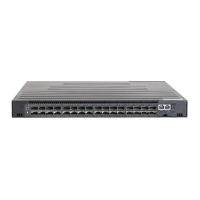C
HAPTER
18
| Using the Command Line Interface
Entering Commands
– 684 –
The configuration commands are organized into different modes:
◆ Global Configuration - These commands modify the system level
configuration, and include commands such as hostname and snmp-
server community.
◆ Access Control List Configuration - These commands are used for
packet filtering.
◆ CFM Configuration - Configures connectivity monitoring using continuity
check messages, fault verification through loopback messages, and
fault isolation by examining end-to-end connections between Provider
Edge devices or between Customer Edge devices.
◆ Class Map Configuration - Creates a DiffServ class map for a specified
traffic type.
◆ ERPS Configuration – These commands configure Ethernet Ring
Protection Switching for increased availability of Ethernet rings
commonly used in service provider networks.
◆ IGMP Profile - Sets a profile group and enters IGMP filter profile
configuration mode.
◆ Interface Configuration - These commands modify the port
configuration such as speed-duplex and negotiation.
◆ Line Configuration - These commands modify the console port and
Telnet configuration, and include command such as parity and
databits.
◆ Multiple Spanning Tree Configuration - These commands configure
settings for the selected multiple spanning tree instance.
◆ Policy Map Configuration - Creates a DiffServ policy map for multiple
interfaces.
◆ Time Range - Sets a time range for use by other functions, such as
Access Control Lists.
◆ VLAN Configuration - Includes the command to create VLAN groups.
To enter the Global Configuration mode, enter the command configure in
Privileged Exec mode. The system prompt will change to
“Console(config)#” which gives you access privilege to all Global
Configuration commands.
Console#configure
Console(config)#

